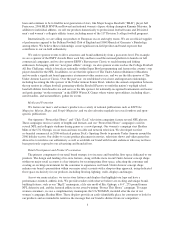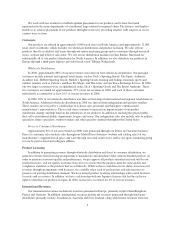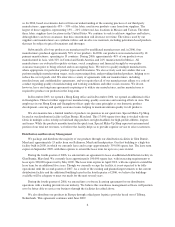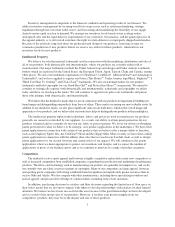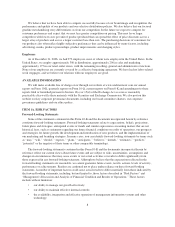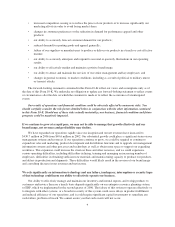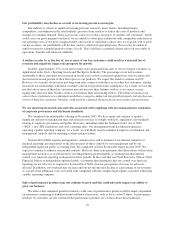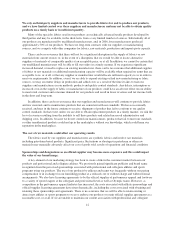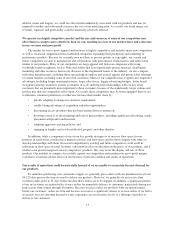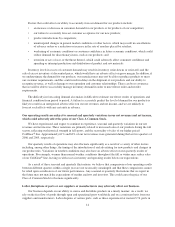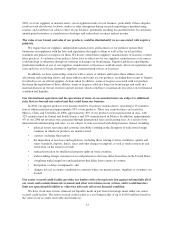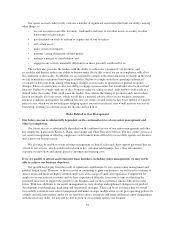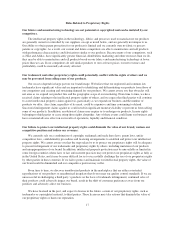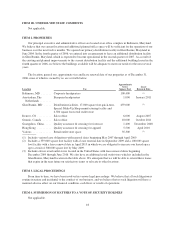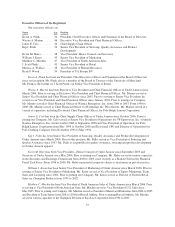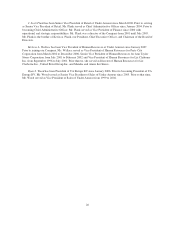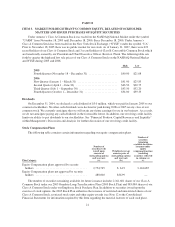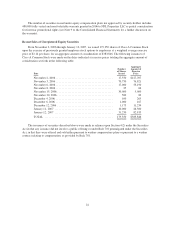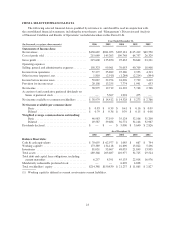Under Armour 2006 Annual Report Download - page 21
Download and view the complete annual report
Please find page 21 of the 2006 Under Armour annual report below. You can navigate through the pages in the report by either clicking on the pages listed below, or by using the keyword search tool below to find specific information within the annual report.athletes, teams and leagues, we could lose the on-field authenticity associated with our products and may be
required to modify and substantially increase the cost of our marketing plan. As a result, our brand image, net
revenues, expenses and profitability could be materially adversely affected.
We operate in a highly competitive market and the size and resources of some of our competitors may
allow them to compete more effectively than we can, resulting in a loss of our market share and a decrease
in our revenues and gross profit.
The market for active sports apparel and footwear is highly competitive and includes many new competitors
as well as increased competition from established companies expanding their production and marketing of
performance products. Because we currently own no fabric or process patents or copyrights, our current and
future competitors are able to manufacture and sell products with performance characteristics and fabrications
similar to our products. Many of our competitors are large apparel and footwear companies with strong
worldwide brand recognition, such as Nike and Adidas that have significantly greater financial, distribution,
marketing and other resources than we do. Because of the fragmented nature of the industry, we also compete
with other manufacturers, including those specializing in outdoor and tactical apparel and private label offerings
of certain retailers, including some of our retail customers. Many of our competitors have significant competitive
advantages, including longer operating histories, larger sales forces, bigger advertising budgets, better brand
recognition among consumers, greater economies of scale and long-term relationships with our key retail
customers that are potentially more important to those customers because of the significantly larger volume and
product mix that our competitors sell to them. As a result, these competitors may be better equipped than we are
to influence consumer preferences or otherwise increase their market share by:
• quickly adapting to changes in customer requirements;
• readily taking advantage of acquisition and other opportunities;
• discounting excess inventory that has been written down or written off;
• devoting resources to the marketing and sale of their products, including significant advertising, media
placement and product endorsement;
• adopting aggressive pricing policies; and
• engaging in lengthy and costly intellectual property and other disputes.
In addition, while a component of one of our key growth strategies is to increase floor space for our
products in retail stores, retailers have limited resources and floor space and we must compete with others to
develop relationships with them. Increased competition by existing and future competitors could result in
reductions in floor space in retail locations, reductions in sales or reductions in the prices of our products, and if
retailers earn greater margins from our competitors’ products, they may favor the display and sale of those
products. Our inability to compete successfully against our competitors and maintain our gross profit margin
could have a material adverse effect on our business, financial condition and results of operations.
Our results of operations could be materially harmed if we are unable to accurately forecast demand for
our products.
To minimize purchasing costs and ensure supply, we generally place orders with our manufacturers at least
90-120 days prior to the time we need to deliver our products. However, we generally do not receive firm
customer orders prior to 21 days before the date those orders are to be shipped. In addition, a significant portion
of our net revenues are generated by at-once orders for immediate delivery to customers, particularly during our
peak season from August through November. Because we place orders for products with our manufacturers
before our customers’ orders are firm and because we receive a significant volume of at-once orders, if we fail to
accurately forecast customer demand we may experience excess inventory levels or a shortage of product to
deliver to our customers.
13


